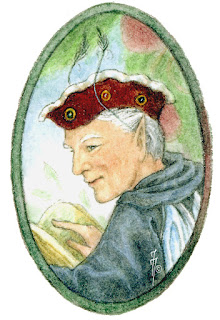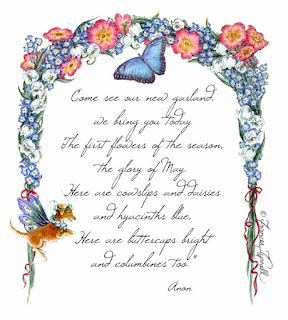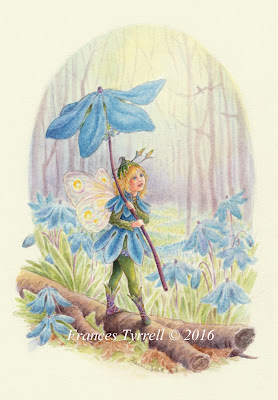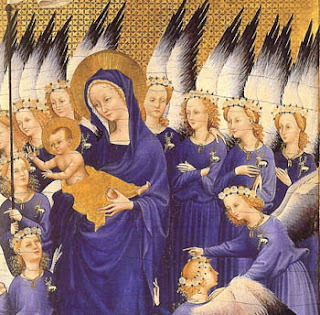new posts in all blogs
Viewing Blog: Fairy Lanterns, Most Recent at Top
Results 26 - 50 of 212

An artist's blog about watercolour, goodness, beauty and truth.
Statistics for Fairy Lanterns
Number of Readers that added this blog to their MyJacketFlap: 5
 |
| Ohm, Fairy Advisor and Printer of the Fairy Gazettes |
"We miss Ohm. Our printer, technical advisor, Dearly Beloved and everlasting friend, has left on the Great Journey that even fairies must take and for now we are parted.
Ohm, in the mortal world, is the unit by which electrical resistance is measured. One "ohm" (Ohm is very good at explaining this) is equal to the current of one ampere which will flow when a voltage of one volt is applied. "Turn up voltage and get more ohms". But for us there is only one Ohm, shining bright and constant. Every flicker of light reminds us that we will meet again."
The robins are back and busy with nestlings. It's the time of year for finding broken shells of beautiful robin's egg blue in the garden. For "daring fledglings who test their wings too soon" Guardian Patrol fairies will come to the rescue with "stretchers of twigs and last year's spiders' webs", according to (who else) Dr. Flora Fauna of (what else?)
The Illustrated Fairy Gazettes, Spring edition.
There is a beautiful Saskatoon Berry tree in my parents' back yard and a nest with robins nearby. They have taken to nesting over the back door and come back every year. Here is one of them, part of a demo piece from my watercolour classes.
 |
| Robin, watercolour, Frances Tyrrell ©2016 |
"A blessed and enchanted Spring to fairies everywhere"
Here are some fairy garlands for the month of May. The May Pole Dance is from the Spring edition of the Fairy Gazettes, where it is accompanied by an article on the etiquette of folded wings. Should it be "Wings Up" or "Wings Down"? Just ask Fairy Faux Pas!
 |
| Spring Garland, © Frances Tyrrell 2016 |
Above, a fairy garland woven from the spring flowers that have naturalized in my garden - forget-me-nots, lily of the valley, and primroses. The flowers of the poem won't show up here until June.
 |
| Snowdrops, © Frances Tyrrell 2016 |
The snowdrops are gone by now. The scillas still abound in wide blue drifts. And here come the trillums, crimson and white.
"A blessed and enchanted Spring to fairies everywhere"
 |
Scilla Fairy
|
The woods nearby are carpeted with Scilla, masses of them in sweeps of heavenly blue. Of European origin, the little blue flowers have naturalized here and become as integral to the landscape as the native Trout Lilies and Trillium. Where there are flowers there must be fairies, hence this Scilla Fairy in Lakeshore Woods, just a short walk from home.
The first blossoms were snowed over early in April
and the preliminary sketch showed the wintry scene, every blossom capped with snow. But that is another painting.
We've had enough snow for a while.
"Come kneel before the radiant Boy
Who brings you beauty, peace and joy.
Jesus your King is born,
Jesus is born.
"The star stopped not far from where Jesus was born
Having found the place it said,
"Come this way"
Jesus, he is born.
(Huron Verses, The Huron Carol)
Is any child in history without some sort of doll or plaything? Huron children made dolls from corn husks, which were stuffed and padded with leaves, had limbs made from braided husk, were adorned with corn silk hair or real hair, and were clothed with more corn husks, animal hide or cloth. A traditional doll had no face, because of the legend about a beautiful corn husk person who lost her face through vanity.
"There was little formal training for children, but they learned skills from their games. Girls helped their mothers with their work. Boys were expected to be hardy, brave and self-reliant." Sainte Marie Among the Hurons
The little girl here is pictured with a cradle board, or baby carrier. During the day an infant would be wrapped in furs and secured to the cradle board, which stood up on the floor of the lodge inside, or outside was carried on the mother's back or carried in front. "Wrapped in furs, the babies were carried in cradleboards filled with soft warm down from bullrushes."
This I was pleased to read from several sources, "With their great sense of dignity, the Huron Wendat felt it was wrong to coerce or publicly humiliate anyone, especially a child. Physical punishment was never used as a discipline." (
Sainte Marie Among the Hurons)
"...and even those who were at a distance of more than two days journey met at a given place to sing hymns in honour of the new-born child.." The Jesuit Relations, 1642
"...they built a small chapel of cedar and fir branches in honour of the manger of the infant Jesus"
Jesuit Relations, 1642
Author of the Huron Carol, Father Jean de Brebeuf, 1593-1649
"an apostle, a brave adventurer, a skilled writer, a careful ethnologist, a man of vision"
With his seven companions, Patron Saint of Canada
"O children of the forest free
O sons of Manitou,
The Holy Child of earth and heaven
There is a history to portrayals of the Madonna in art, and it spills over into portrayals of the angels too. It begins, I was taught, with St. Luke's portrait of Mary, and was respectfully copied by generations of artists with only modest changes.
Here is Cimabue's Madonna Enthroned with Angels and Prophets: Inclined head, three quarter profile, straight nose, wide eyes, small mouth, the Infant's profile a mirror image, the angels echoing the Madonna's features and pose.
 |
| Cimabue, Madonna Enthroned with Angels and Prophets, 1285-86 |
A hundred years later, here is the Wilton Diptych (1395–1399), in International Gothic style with gorgeous blues, and the same features, profile, pose, and echoing angels.
 |
| Wilton Diptych, 1395-1399 |
A little later, the Madonna and Child with Angels, by Fra Angelico, 1395/1400-1455. The faces are a bit different but follow the same pattern.
 |
| Madonna and Child with Angels, Fra Angelico, 1395/1400-1455 |
A hundred years later, Madonna and Child with Singing Angels, Sandro Botticelli 1445-1510. There has been a jump in sophistication; these could be portraits of people we meet today. This Madonna is shown face on, but still with the classic tilt to her head, and the angels' features are echos of each other.
 |
| Madonna and Child with Singing Angels, Sandro Botticelli 1445-1510 |
And that, dear readers, is why I painted the angels in the Huron Carol like this:
From very far, a Kootenay chief of the West coast. First Nations peoples traveled and traded goods, but there were certain geographic limitations - over the Rocky Mountains was too far for this chief, a kind advisor said. But this is a story about miracles and wonders, the impossible made possible. A few mountains wouldn't get in the way.
From the Eastern Woodlands, a Shawnee chief.
How can an artist know how these long-ago people looked, how they dressed and behaved and interacted with others? The diaries and letters of the Jesuit Relations are a valuable resource, as well as other contemporary records, drawings and diaries that also document the oral history of the First Nations. In the Huron Carol we are in allegory, that the nativity in long ago Palestine could just as well have happened among any other people, that "the Word was made flesh and dwelt among us" applies to all of humankind. For the artist, the aim is to represent a common human experience: awe and reverence when meeting true beauty and the divine.
Sioux Chief, of "chiefs from far". Neither the French, English nor Huron verses stipulate how far the "men of authority" would have traveled. I gave it my best shot, choosing near, not so near, and very far. The Sioux were well to the west of Huronia, on the Great Plains.
Day by day the Wise Men get closer, on their long journey from their homelands as they follow the signs in the sky.
Brebeuf's Huron verses read,
"Three men of great authority have left for the place of his birth
Tiscient, the star appearing over the horizon leads them there
The star will walk first on the path to guide them
Jesus, he is born.
A detail from the border of deer, antlers and swirling snow. There were four tribes or nations in the Huron confederacy, the Bear, the Cord, the Rock and the Deer tribes.
The Lynx, another faint constellation in the northern hemisphere and not usually associated with any myths. In First Nations stories the Lynx is the name of the daughter of the Sky Woman, she who fell to Earth through a hole in the Sky World and for whom the Elder Creatures of the Earth prepared a safe place to land, Turtle Island (North America).
Aries the ram, "a rather inconspicuous northern constellation". I don't know if there is an Iroquoian or First Nations name or legend for the constellation or the first point of Aries, the location of the vernal equinox. I placed the ram here, galloping across the starry firmament, as one of many northern creatures with a heavenly counterpart.
The Great Bear, Ursa Major. A detail from the big border of stars and heavenly creatures. I wanted to match constellations with northern wildlife and started with the Great Bear.
The Northern Lights, the heavenly dancers. I remember my mother waking me up one night to walk under the blue-green lights flickering across the sky. In later years I slept under the Northern Lights on canoe trips. They had to have a place in the book.
There is no reference for them in the English verses by J. Edgar Middleton but there is this in Brebeuf's original verses in Huron:
The okie spirits who live in the sky are coming with a message,
They're coming to say, "Rejoice!
Mary has given birth. Rejoice!
Jesus he is born."
Here are the hunter braves, the first to hear the angels' song.
Earth and sky again, linked by smoke rising from hearths to heaven. The angel song is for the children by the stream and the hunters deeper in the forest, for all who have ears to hear,
"And as the hunter braves drew nigh
The angel song rang loud and high"
Not a stable but a longhouse, in this version of the nativity. And connecting earth and sky, mortals and immortals, is the rising smoke from the hearth, the heart of the family.
 |
Young Hunters, The Huron Carol
"Before their light the stars grew dim,
and wond'ring hunters heard the hymn." |
Coming home from play in blue-shadowed snows was a frequent scene of my Quebec childhood. The snow squeaked under our boots while the first stars came out in the blue and gold of twilight. When I visited Sainte Marie in the wintertime 9 years ago it was very like this picture - white snows, blue shadows, iron-cold flakes of snow landing on our faces, and the sound of the wind in the trees.
View Next 25 Posts











































